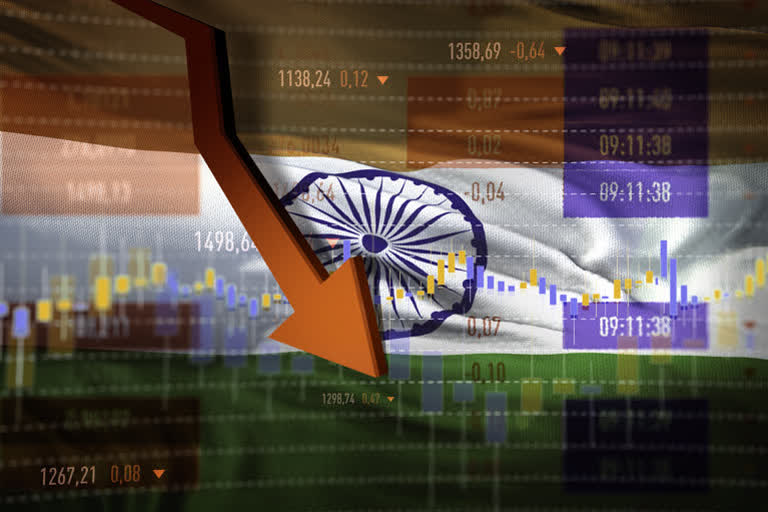Hyderabad: The GDP is likely to contract by 8.6 per cent for the July-September period, which means India will enter into a recession for the first time in history in the first half of this fiscal with two successive quarters of negative growth due to the Covid-19 pandemic, as per an RBI official.
Researchers have used the 'nowcasting' method to arrive at the estimates ahead of the official release of data and their views in an article in RBI's monthly bulletin released on Wednesday do not constitute the central bank's views.
The pandemic-induced lockdowns had led to a steep contraction of 23.9 per cent in the GDP for the April-June quarter as compared to the same period a year ago.
The RBI has estimated that the economy will contract by 9.5 per cent for the full fiscal year. "India has entered a technical recession in the first half of 2020-21 for the first time in its history with Q2 2020-21 likely to record the second successive quarter of GDP contraction," as per the article titled 'Economic Activity Index', authored by Pankaj Kumar of the Monetary Policy Department.
What is recession?
Recession is defined as a fall in the overall economic activity for two consecutive quarters (six months) accompanied by a decline in income, sales, and employment.

Read: GDP to contract 8.6 pc in Q2; India has entered recession for first time: RBI official
FY58 - Balance of Payment (BoP) crisis
The year 1957 was a difficult period for the agriculture sector. Weak monsoon adversely affected agricultural production, which led to an increase in prices. The government which had already imported 20 lakh tonnes of food grains in the previous fiscal had to further import 40 lakh tonnes. During 1957-58, India encountered its first drop in economic growth when a negative GDP growth of 1.2 per cent was recorded. The reason behind it was a ballooning import bill which swelled by more than 50 per cent between 1955 and 1957. During the same time exports registered a sluggish growth. India's trade deficit widened by over 9 times from $0.1 billion in 1955 to almost $0.9 billion in 1957 while gold stock and foreign reserves were reduced to half.
FY66 - Severe Drought
India which had fought wars with China in 1962 and more recently with Pakistan in 1965 was in a recovery stage. The very next year, two severe droughts affected the Indian economy (during 1966 & 1967). During that time India had a heavy reliance on foreign aid, especially from the US. In FY1966, due to drought, food grain production fell 20 per cent. Foreign food aid came to the rescue of the starving population. India received 70 lakh tonnes of food aid in fiscal 1965, equivalent to 10 per cent of domestic production. In fiscal 1966 India received 1 crore tones of food aid. In 1965-66 India registered an economic contraction of -3.66%.
Read: India has entered into recession due to PM Modi's policies: Rahul Gandhi
FY73 - Energy Crisis
In 1973, the world witnessed its first energy crisis as the Organisation of Arab Petroleum Exporting Countries (OAPEC) proclaimed an oil embargo (an embargo is an official ban on an activity or trade with a particular country). It targeted nations that were supporting Israel during the ongoing "yom kippur" war. As a result, in a short while, oil prices shot up 400 per cent from $3 to $12. Consequently, India's oil import bill rose from $414 million in 1972-73 to $900 million till 1973-74. This was twice the amount of foreign exchange reserves present at that time. Since then energy became a topmost priority for India. In 1972-73, India's economy contracted by 0.32%.
FY80 - Oil Shock leading to BoP crisis
The world witnessed a second oil shock during 1979-80. It occurred due to a decrease in oil production in the wake of Iranian revolution and led to increase in oil prices. This was followed by Iran-Iraq war which further curtailed production and escalated prices. This led to a serious crisis as the cost of India's imports almost doubled between 1978-79 to 1981-82. During this time, India's exports also took a hit as it contracted by 8%, which led to a balance of payment crisis.
FY21- Lockdown killing economic activity
According to economists, the economy shrank for the second straight quarter. The government had in August reported a 23.9 per cent contraction in its Gross Domestic Product (GDP) for the April-June quarter. RBI Report said that Gross Domestic Product (GDP) for the July-September quarter is set for a contraction of 8.6 per cent.
Read: Congress terms stimulus package as Centre's 'Headline Management'



